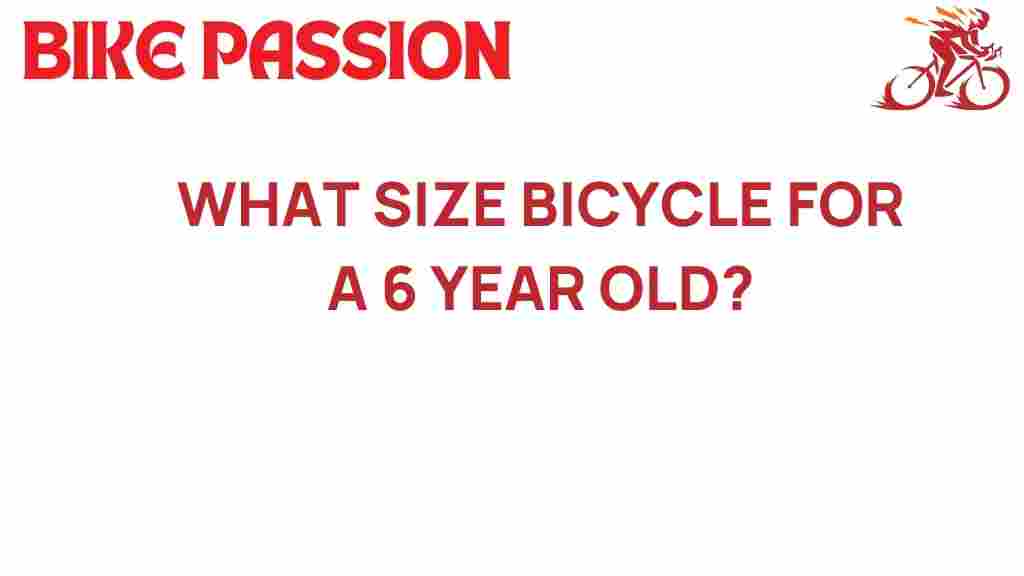The Perfect Fit: Choosing the Right Bicycle Size for Your 6-Year-Old
When it comes to finding the perfect bicycle size for your 6-year-old, understanding the nuances of bicycle size is crucial. Kids bikes come in various sizes, and selecting the right one ensures not only comfort but also safety and enjoyment during child cycling adventures. In this comprehensive guide, we’ll explore the importance of proper bike fitting, offer practical cycling tips, and help you make informed decisions for your child’s outdoor activity.
Why Bicycle Size Matters
The right bicycle size is essential for several reasons:
- Safety: A properly fitted bike reduces the risk of accidents and injuries.
- Comfort: Your child will enjoy riding more if the bike fits them well.
- Control: A correctly sized bike allows better control, making it easier for young riders to navigate.
Understanding Kids Bikes
Kids bikes are generally categorized by wheel size rather than frame size. For a 6-year-old, typical wheel sizes range from 14 to 20 inches. Here’s a quick breakdown:
- 14-inch wheels: Suitable for younger 5-6-year-olds or shorter children.
- 16-inch wheels: Ideal for average-sized 6 to 7-year-olds.
- 18-inch wheels: A good fit for taller 7 to 8-year-olds.
- 20-inch wheels: Recommended for older or more advanced young cyclists.
Choosing the right wheel size not only enhances the riding experience but also encourages confidence as they develop their cycling skills.
How to Measure Your Child for a Bike
To determine the correct bicycle size, follow these simple steps:
Step 1: Measure Your Child’s Height
Have your child stand straight against a wall without shoes. Measure their height from the ground to the top of their head. This measurement helps in selecting the appropriate bike size.
Step 2: Inseam Measurement
The inseam is a crucial measurement that affects bike fitting. To measure, have your child stand with their feet shoulder-width apart. Measure from the ground to the top of their inner thigh. This measurement will guide you in choosing the right frame height.
Step 3: Try Different Bikes
Visit a local bike shop with your child. Allow them to sit on different models to see which feels the most comfortable. Pay attention to the following:
- Leg Position: Your child should be able to touch the ground with their toes while seated.
- Reach: Their arms should be slightly bent when holding the handlebars.
- Posture: Ensure they can sit upright and maintain balance without straining.
Adjusting for a Perfect Fit
Once you’ve selected a bike, adjustments might be necessary for an optimal fit:
- Seat Height: Adjust the seat so your child can place their feet flat on the ground while sitting.
- Handlebar Height: Ensure handlebars are at a comfortable height, ideally level with the seat.
- Brakes and Gears: Make sure they can easily reach the brakes and any gear shifts.
Regular adjustments may be needed as your child grows, so keep an eye on their comfort and control during rides.
Safety First: Cycling Tips for Young Riders
Ensuring your child’s safety while cycling is paramount. Here are essential tips to consider:
- Wear a Helmet: Always ensure your child wears a properly fitted helmet to protect against head injuries.
- Visibility: Dress your child in bright colors, and consider adding reflectors or lights for visibility.
- Supervision: Always supervise younger children while they ride, especially in traffic.
- Teach Hand Signals: Educate your child on how to signal turns and stops to promote safe riding.
Choosing the Right Type of Bike
When selecting a bike, consider the type of cycling your child will be doing. Here are some popular options:
- Balance Bikes: Ideal for beginners, helping them learn balance without pedals.
- Single-Speed Bikes: Great for younger children learning to ride, as they are easy to operate.
- Multi-Speed Bikes: Suitable for older kids who may want to ride on varying terrains.
- Mountain Bikes: Perfect for adventurous young riders who enjoy trails and rough paths.
Common Troubleshooting Tips
Even with the right size and adjustments, you may encounter some issues while your child learns to ride. Here are some troubleshooting tips:
1. Difficulty Balancing
If your child struggles with balance, consider:
- Using training wheels for additional support.
- Practicing on a flat, open area to build confidence.
2. Inability to Reach the Pedals
If your child can’t comfortably reach the pedals, ensure the seat is at the correct height. If they still struggle, consider switching to a smaller bike.
3. Fear of Falling
Encourage your child by:
- Practicing in a safe environment.
- Offering positive reinforcement and celebrating small victories.
Encouraging Outdoor Activity
Introducing your child to cycling opens up a world of outdoor activity that promotes physical health and family bonding. Here are some benefits:
- Physical Health: Cycling helps improve cardiovascular fitness, strength, and flexibility.
- Mental Well-Being: Outdoor cycling can reduce stress and anxiety while boosting mood.
- Family Time: Shared cycling experiences create lasting memories and strengthen family bonds.
Consider planning family bike rides or joining local cycling events to foster a love for cycling.
Conclusion
Choosing the right bicycle size for your 6-year-old is a vital step in ensuring they have a safe, enjoyable cycling experience. By understanding kids bikes, measuring properly, and making the necessary adjustments, you can help your child thrive in their cycling journey. Always prioritize safety, encourage outdoor activity, and embrace the joy of child cycling. For more tips and resources on youth bicycles, check out this parent guide to cycling.
With the right bike fitting and guidance, your child will not only develop essential cycling skills but also create cherished memories that last a lifetime.
This article is in the category Gear and created by BikePassion Team
